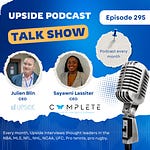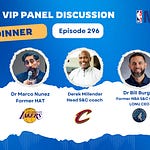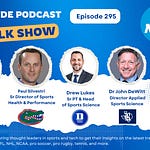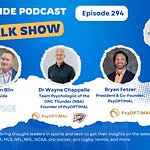Today we have the honor of interviewing Dr. Stefan Valdes, a Doctor of Physical Therapy (DPT), Board-Certified Sports Specialist (SCS), and Certified Strength & Conditioning Coach (CSCS).
A Miami native, he founded Movement Lab in 2019 to bridge the gap between rehab and performance. Dr. Stefan specializes in sports and orthopedic rehab, bringing experience from the collegiate level, private sector, and the NBA, where he previously served as a hybrid Physical Therapist and Strength Coach for the Oklahoma City Thunder and Detroit Pistons.
Pictures: Dr Stefan Valdes with Ben Simmons (LA Clippers) (Left) and Josh Hart (NY Knicks) (Right).
Today, he works with NBA (e.g. Josh Hart/NY Knicks), NFL, and other pro athletes during their off-season programs and consults with athletes and teams throughout the year. Through his partnership with Total Performance, Dr. Stefan utilizes cutting-edge Ultrasound Tissue Characterization (UTC) technology to monitor tendon health, helping prevent tendinopathy and guide recovery of those already dealing with it. His approach blends evidence-based physical therapy with elite performance training to help athletes not just recover — but perform at their highest level.
📝Show Notes: Through this interview, we touched on his background, his experienced working in the NBA (OKC, Detroit Pistons), and building his own practice in Miami, and working with NBA/NFL players during the off season. We also discussed the differences between NBA and NFL players, the lessons he learned from his time in the NBA, the trends he sees in the performance tech world, and what makes Josh Hart (NY Knicks), one of the NBA players he works with, such as a special player.
You can read the full transcript of the podcast interview with Stefan located at the top of this blog post.
Of note, Dr Stefan Valdes will be speaking at our 2025 Upside US Sports Tech Summit on October 23 at a world’s class sports stadium in Sunrise FL.
Here are the best quotes from the interview with Stefan:
Q1. His Journey into Strength and Conditioning, NBA and NFL Work
“I was always fascinated by the human body and how it adapts under stress—both physically and mentally. That curiosity led me down the path of biomechanics in school, but it was when I got into strength and conditioning that I really saw the potential for impact. I started at the collegiate level, working with athletes across different sports, but the turning point came during an internship with an NFL team. That experience showed me how tightly performance, data, and recovery can be integrated. It was high stakes, fast learning. Eventually, I moved into the NBA, where the challenge became not just performance peaks, but maintaining output over 82 games and travel. That complexity—individualizing performance strategies while keeping durability in mind—is what really pulled me deeper into this space.”
Q2. The Differences Between NBA and NFL Players
“The physical demands are night and day. NFL players train for explosive power, short bursts of contact, and mass that can withstand hits. NBA players, on the other hand, live in the world of elasticity—it's about joint resilience, reactive strength, and being able to move efficiently over a much longer season. Mentally, there’s also a big gap. NFL guys tend to have a war-ready mindset—gearing up for one game a week that’s all-out. NBA athletes need to stay sharp and adapt quickly over months of continuous play and travel. You don’t have time to ‘peak’—you have to manage energy and performance like a marathon. Recovery in the NBA isn’t a luxury—it’s a fundamental part of the training system. If you don’t plan for it, you lose guys to soft-tissue injuries and burnout fast.”
Q3. The Lessons He learned from His Time in the NBA
“One of the biggest lessons I took from my time in the league is that longevity isn’t just about strength or VO2 max—it’s about rhythm. Sleep, circadian patterns, stress regulation—if those are off, everything else starts to slide. I saw it time and time again: players who traveled poorly or didn’t adapt to time zone shifts would see their reaction time and decision-making deteriorate. We had to go beyond just lifting or running protocols. You can’t just chase outputs—you need to build a system that protects the human behind the performance. It taught me to prioritize consistency and sustainability over highlight metrics.”
Q4. His Evolving Approach After Moving Into Private Practice
“Since starting my own practice, I’ve had the freedom to train athletes without the constraints of a game schedule or organizational structure, and that’s been a game changer. I can build blocks that actually follow adaptation science instead of rushing from one peak to another. I’ve also become more holistic in my methods. I’m integrating more neurocognitive tools, breathwork, and recovery education—especially with athletes coming off injury or dealing with chronic compensation patterns. The big shift for me is coaching the person first, the athlete second. That might sound simple, but when you’re in a team setting, it’s easy to fall into routines. Now, I listen more, customize more, and aim for long-term results over short-term fixes.”
Q5. The Performance Trends In Tech That He is Excited About
“I’m really excited about technologies that provide real-time neuromuscular feedback—things that let you adjust a lift, a sprint, or a rehab session on the fly based on how the nervous system is responding. We're also learning a lot more about perception and motor control. Tools that measure how vision, balance, and foot strike patterns interact can give you a much clearer picture of readiness or fatigue. And on the equipment side, I think low-load, high-stimulus approaches like flywheel training, blood flow restriction, and isometrics are going to be essential tools—not just for performance but for managing central nervous system load and recovery in-season.”
Q6. What Makes Josh Hart (NY Knicks) Special
“Josh has one of the most elite internal engines I’ve ever seen. When you look at his workload metrics—miles covered, high-effort plays, back-to-backs—most players would break down at that output. But he thrives on it. He brings a blue-collar work ethic into a high-skill league, and that’s a rare mix. He’s the type of athlete who doesn’t just show up for the big moments; he brings the same intensity to training, walkthroughs, and recovery. It’s not just his conditioning—it’s his consistency. That’s his superpower. You can rely on him every night because he does all the little things right behind the scenes.”
You may also like:
🔥 Upside Chat: Marco Nunez, Former Head Athletic Trainer (LA Lakers/NBA), on Athletic Trainer's Role, Post Career After Elite Sports, and Entrepreneurship
This week we had the honor to interview Marco Nunez, the former Head Athletic Trainer for the LA Lakers (NBA). Marco worked for the LA Lakers for 12 years with world’s class athletes like Kobe Bryant, Shaq or Lebron James.
🎙️ Upside Chat with John DeWitt, Director of Applied Sports Science, Athletic Department, Faculty Member, Rice University (NCAA).
Today we have the honor of interviewing Dr. John DeWitt, the director of applied sports science in the athletic department and a faculty member at Rice University (NCAA).














